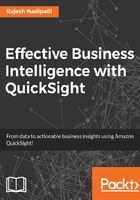
Supported data sources
QuickSight supports broadly three types of data sources: relational, file, and SaaS. For relational sources it supports Athena, RDS, Redshift, MySQL, and SQL Server sources. For file sources, it supports Excel, CSV, and common log formats in S3. For SaaS it supports Salesforce.
Before we explore data sources, I would like the readers to get familiar with QuickSight concept of data source and dataset. A data source identifies sources like relational database, S3 filesystem, and SaaS system like SAP. A dataset identifies specific data in a data source, for example, a table is a dataset in a RDBMS data source. A dataset is imported into SPICE for fast access.
Now let's explore the list of supported data sources using the following steps:
- From the QuickSight home page click on Manage data, which will show a list of existing datasets and a summary of your current SPICE utilization, as shown in the following screenshot:

Figure 2.2: Adding a new dataset
- Next from this page (Manage data), click on New data set to see the list of sources that QuickSight can connect to, as shown in the following screenshot:

Figure 2.3: Supported datasets
Let's review this list of data sources in detail:
- Files you can upload from your laptop in common formats that is, delimited (
.csv,.tsv), log files (.clf), extended log files (.elf), and Excel (.xlsx). - Salesforce cloud instance.
- Files in S3, that is, delimited (
.csv,.tsv), log files (.clf), and extended log files (.elf). S3 also supports compressed files if.gzipis used; for other compressed formats, you will need to decompress first before importing them. - Athena service that allows SQL queries on S3.
- RDS instances for MySQL (any version), PostgreSQL (any version), and Microsoft SQL Server 2012. You can source from any table and in case of PostgreSQL, the materialized view is also supported.
- Redshift cluster.
- Redshift external account.
- MySQL in Amazon EC2, on your local network or in some other Internet accessible environment.
- PostgreSQL in Amazon EC2, on your local network or in some other Internet accessible environment.
- SQL Server in Amazon EC2, on your local network or in some other Internet accessible environment.
- Aurora service provides MySQL or PostgresSQL compatible databases at lower cost and improved performance than the standard open source databases.
- MariaDB in Amazon EC2, on your local network or in some other Internet accessible environment.
- Files you can upload from your laptop in common formats that is, delimited (